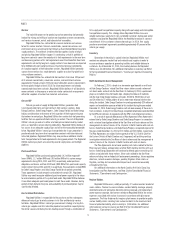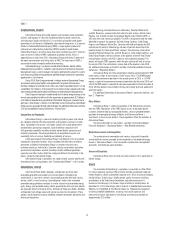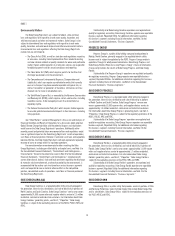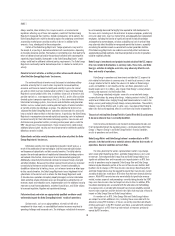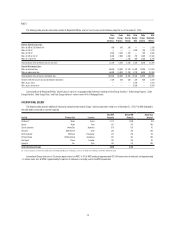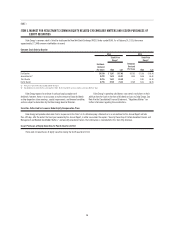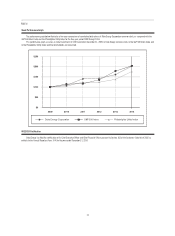Duke Energy 2014 Annual Report Download - page 38
Download and view the complete annual report
Please find page 38 of the 2014 Duke Energy annual report below. You can navigate through the pages in the report by either clicking on the pages listed below, or by using the keyword search tool below to find specific information within the annual report.
PART I
18
delays, weather, labor relations, force majeure events, or environmental
regulations affecting any of these fuel suppliers, could limit the Duke Energy
Registrants to operate their facilities. Should counterparties fail to perform, the
Duke Energy Registrants might be forced to replace the underlying commitment
at prevailing market prices possibly resulting in losses in addition to the
amounts, if any, already paid to the counterparties.
Certain of the Duke Energy Registrants’ hedge agreements may result in
the receipt of, or posting of, derivative collateral with counterparties, depending
on the daily derivative position. Fluctuations in commodity prices that lead to the
return of collateral received and/or the posting of collateral with counterparties
negatively impact liquidity. Downgrades in the Duke Energy Registrants’ credit
ratings could lead to additional collateral posting requirements. The Duke Energy
Registrants continually monitor derivative positions in relation to market price
activity.
Potential terrorist activities or military or other actions could adversely
affect the Duke Energy Registrants’ businesses.
The continued threat of terrorism and the impact of retaliatory military
and other action by the U.S. and its allies may lead to increased political,
economic and fi nancial market instability and volatility in prices for natural
gas and oil, which may have material adverse effects in ways the Duke Energy
Registrants cannot predict at this time. In addition, future acts of terrorism and
possible reprisals as a consequence of action by the U.S. and its allies could be
directed against companies operating in the U.S. or their international affi liates.
Information technology systems, transmission and distribution and generation
facilities such as nuclear plants could be potential targets of terrorist activities
or harmful activities by individuals or groups. The potential for terrorism has
subjected the Duke Energy Registrants’ operations to increased risks and could
have a material adverse effect on their businesses. In particular, the Duke Energy
Registrants may experience increased capital and operating costs to implement
increased security for their information technology systems, transmission and
distribution and generation facilities, including nuclear power plants under the
NRC’s design basis threat requirements. These increased costs could include
additional physical plant security and security personnel or additional capability
following a terrorist incident.
Cyberattacks and data security breaches could adversely affect the Duke
Energy Registrants’ businesses.
Information security risks have generally increased in recent years as a
result of the proliferation of new technologies and the increased sophistication
and frequency of cyberattacks and data security breaches. The utility industry
requires the continued operation of sophisticated information technology systems
and network infrastructure, which are part of an interconnected regional grid.
Additionally, connectivity to the Internet continues to increase through smart grid
and other initiatives. Because of the critical nature of the infrastructure, increased
connectivity to the Internet and technology systems’ inherent vulnerability to
disability or failures due to hacking, viruses, acts of war or terrorism or other types
of data security breaches, the Duke Energy Registrants face a heightened risk of
cyberattack. In the event of such an attack, the Duke Energy Registrants could
(i) have business operations disrupted, property damaged, customer information
stolen and other private information accessed (ii) experience substantial loss of
revenues, repair and restoration costs, implementation costs for additional security
measures to avert future cyberattacks and other fi nancial loss, and (iii) be subject
to increased regulation, litigation and reputational damage.
Failure to attract and retain an appropriately qualifi ed workforce could
unfavorably impact the Duke Energy Registrants’ results of operations.
Certain events, such as an aging workforce, mismatch of skill set or
complement to future needs, or unavailability of contract resources may lead to
operating challenges and increased costs. The challenges include lack of resources,
loss of knowledge base and the lengthy time required for skill development. In
this case, costs, including costs for contractors to replace employees, productivity
costs and safety costs, may rise. Failure to hire and adequately train replacement
employees, including the transfer of signifi cant internal historical knowledge
and expertise to new employees, or future availability and cost of contract labor
may adversely affect the ability to manage and operate the business, especially
considering the workforce needs associated with nuclear generation facilities.
If the Duke Energy Registrants are unable to successfully attract and retain an
appropriately qualifi ed workforce, their fi nancial position or results of operations
could be negatively affected.
Duke Energy’s investments and projects located outside of the U.S. expose
it to risks related to fl uctuations in currency rates. These risks, and Duke
Energy’s activities to mitigate such risks, may adversely affect its cash
fl ows and results of operations.
Duke Energy’s operations and investments outside the U.S. expose it to
risks related to fl uctuations in currency rates. As each local currency’s value
changes relative to the U.S. dollar, the value in U.S. dollars of Duke Energy’s
assets and liabilities in such locality and the cash fl ows generated in such
locality, expressed in U.S. dollars, also change. Duke Energy’s primary foreign
currency rate exposure is to the Brazilian Real.
Duke Energy selectively mitigates some risks associated with foreign
currency fl uctuations by, among other things, indexing contracts to the U.S. dollar
and/or local infl ation rates, hedging through debt denominated or issued in the
foreign currency and hedging through foreign currency derivatives. These efforts,
however, may not be effective and, in some cases, may expose Duke Energy to
other risks that could negatively affect its cash fl ows and results of operations.
The costs of retiring Duke Energy Florida’s Crystal River Unit 3 could prove
to be more extensive than is currently identifi ed.
Costs to retire and decommission the plant could exceed estimates and,
if not recoverable through the regulatory process, could adversely affect Duke
Energy’s, Progress Energy’s and Duke Energy Florida’s fi nancial condition,
results of operations and cash fl ows.
Duke Energy Ohio’s and Duke Energy Indiana’s membership in an RTO
presents risks that could have a material adverse effect on their results of
operations, fi nancial condition and cash fl ows.
The rules governing the various regional power markets may change,
which could affect Duke Energy Ohio’s and Duke Energy Indiana’s costs and/
or revenues. To the degree Duke Energy Ohio and Duke Energy Indiana incur
signifi cant additional fees and increased costs to participate in an RTO, their
results of operations may be impacted. Duke Energy Ohio and Duke Energy
Indiana may be allocated a portion of the cost of transmission facilities built
by others due to changes in RTO transmission rate design. Duke Energy Ohio
and Duke Energy Indiana may be required to expand their transmission system
according to decisions made by an RTO rather than their own internal planning
process. While RTO transmission rates were initially designed to be revenue
neutral, various proposals and proceedings currently taking place by the FERC
may cause transmission rates to change from time to time. In addition, RTOs
have been developing rules associated with the allocation and methodology
of assigning costs associated with improved transmission reliability, reduced
transmission congestion and fi rm transmission rights that may have a fi nancial
impact on Duke Energy Ohio and Duke Energy Indiana.
As members of an RTO, Duke Energy Ohio and Duke Energy Indiana
are subject to certain additional risks, including those associated with the
allocation among RTO members, of losses caused by unreimbursed defaults
of other participants in the RTO markets and those associated with complaint
cases fi led against an RTO that may seek refunds of revenues previously
earned by RTO members.



